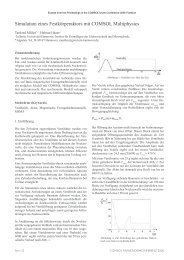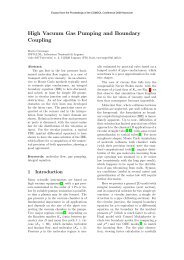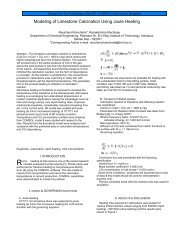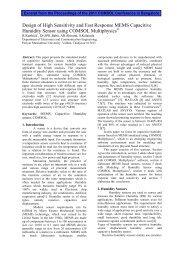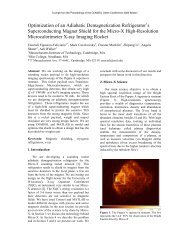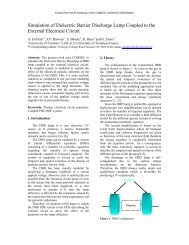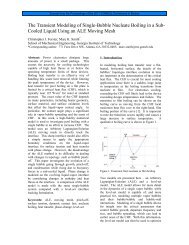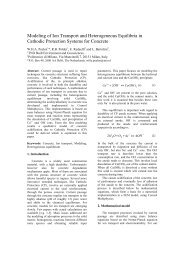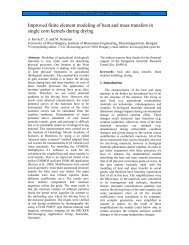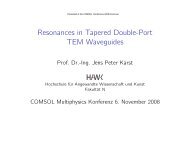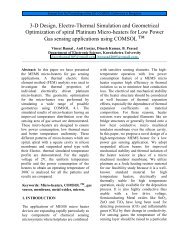Download Paper - COMSOL.com
Download Paper - COMSOL.com
Download Paper - COMSOL.com
Create successful ePaper yourself
Turn your PDF publications into a flip-book with our unique Google optimized e-Paper software.
Finally, the corresponding generalized inertial<br />
loads due to blade rotation appearing in Eq.<br />
(3) are obtained from the following <strong>com</strong>bination<br />
of the distributed inertial loads [2]<br />
⎧<br />
⎪⎨<br />
⎪⎩<br />
¯Z r u = px<br />
¯Z r v = py − q ′ z<br />
¯Z r w = pz + q ′ y<br />
¯Z r φ = qx + v ′ qy + w ′ qz<br />
3. External aerodynamic loads<br />
Aeroelastic applications of the blade structural<br />
model outlined in Section 2 require the introduction<br />
of the aerodynamic loads forcing the<br />
blade dynamics. Here, for the sake of simplicity,<br />
the aerodynamic loads are derived from a quasisteady<br />
approximation of the Greenberg theory<br />
[12] for airfoils. Aerodynamic three-dimensional<br />
effects are taken into account by including a<br />
wake inflow model (see, for instance, Ref. [4]<br />
for details). Thus, section force, T , orthogonal<br />
to the chord, and section force, S, parallel to the<br />
chord are given by<br />
<br />
ϱ Clαc T = −UP UT +<br />
2<br />
c<br />
2 ω UT − c<br />
4 ˙ <br />
c<br />
<br />
2<br />
UP + ˙ω<br />
4<br />
<br />
ϱ Clαc S = U<br />
2<br />
2 P − c<br />
2 ω UP − Cd0<br />
U 2 <br />
T<br />
Clα<br />
while the section pitching moments with respect<br />
to the quarter-chord point reads<br />
<br />
ϱ Clαc3 Mφ = − ω UT −<br />
32<br />
˙ UP + 3c<br />
8 ˙ω<br />
<br />
In the equations above, UP and UT are, respectively,<br />
the quarter-chord velocity <strong>com</strong>ponents normal<br />
and parallel to the chord after deformation,<br />
ω is the section angular velocity, c denotes the<br />
chord length, ϱ is the air density, Clα is the lift<br />
slope coefficient, while Cd0 is the drag coefficient.<br />
Next, the blade aeroelastic equations are derived<br />
by expressing UP , UT and ω in terms of<br />
u, v, w and φ and expressing the aerodynamic<br />
forces given above, T and S, in terms of <strong>com</strong>ponents,<br />
Lv and Lw, in the local blade undeformed<br />
frame of reference. Indeed, in Eq. (1) they contribute<br />
to the virtual work term as follows<br />
δW = Lv δv + Lw δw + Mφ δφ (4)<br />
4. Implementation in Comsol Multiphysics<br />
The implementation in Comsol Multiphysics<br />
of both blade structural model and aerodynamic<br />
loads has been ac<strong>com</strong>plished as a modification<br />
of the 3D Euler-Bernoulli beam model present<br />
in Comsol Multiphysics 3.5a Structural Mechanics<br />
package. This choice has been motivated<br />
mainly by the following two reasons: (i) the<br />
3D Euler-Bernoulli beam model in Comsol Multiphysics<br />
has the same degrees of freedom of<br />
the rotating beam model to be implemented,<br />
and (ii) in the 3D Euler-Bernoulli finite element<br />
model transformations between global and local<br />
coordinate systems are automatically available.<br />
The model has been implemented replacing<br />
both weak and dweak terms appearing in<br />
the 3D Euler-Bernoulli beam model with those<br />
given in Eqs. (2) and (3), and defining all the<br />
parameters involved in them as global and local<br />
variables. Aerodynamic forces and moments appearing<br />
in Eq. (4) have been included as external<br />
distributed loads. The model implemented<br />
may be applied for static and dynamic solutions,<br />
as well as eigenvalue analysis.<br />
5. Results<br />
The aim of the numerical investigation is<br />
the validation of the finite element model implemented<br />
in Comsol Multiphysics in terms of<br />
both free-vibration analysis and aeroelastic response<br />
of a helicopter blade with sweep and anhedral<br />
angles at the tip (see Fig. 2). In particular,<br />
results from the present solver are <strong>com</strong>pared<br />
with numerical and experimental data available<br />
in the literature.<br />
y<br />
z<br />
R<br />
R<br />
BLADE ROOT<br />
Figure 2: Blade tip sweep, ΛS, and anhedral, ΛA,<br />
angles.<br />
Λ<br />
Λ<br />
S<br />
A<br />
x<br />
x<br />
R<br />
R



